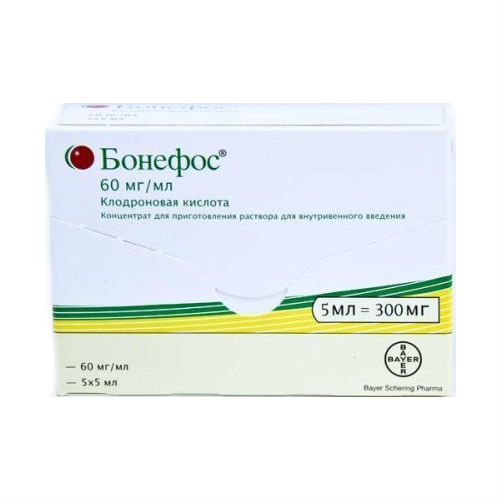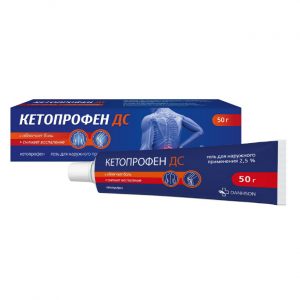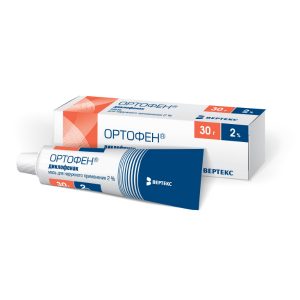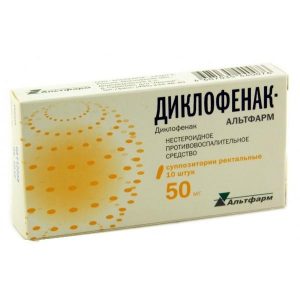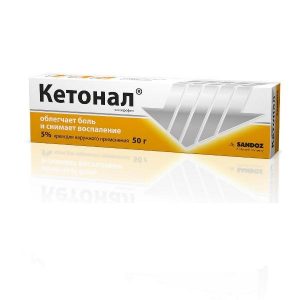Description
Release form
Concentrate for solution for intravenous administration
Packaging
5 pcs
Pharmacological action of
Clodronic acid belongs to the group of bisphosphonates and is an analogue of natural pyrophosphate. Bisphosphonates have a high affinity for the mineral components of bone tissue. The main mechanism of action of clodronic acid is the suppression of the activity of osteoclasts and the decrease in bone resorption mediated by them.
The ability of clodronic acid to inhibit bone resorption in humans has been confirmed through histological, kinetic and biochemical studies. However, the exact mechanisms of this process are not fully understood. Clodronic acid inhibits the activity of osteoclasts, reducing the concentration of calcium in the blood serum, as well as the excretion of calcium and hydroxyproline in the urine. In vitro bisphosphonates inhibit the precipitation of calcium phosphate, block its transformation into hydroxyapatite, delay the aggregation of apatite crystals into larger crystals and slow down the dissolution of these crystals. When using clodronic acid in monotherapy in doses sufficient to inhibit bone resorption, the effect on normal bone mineralization in humans was not observed. In patients with breast cancer and multiple myeloma, a decrease in the probability of bone fractures was noted. Clodronic acid reduces the incidence of bone metastases in primary breast cancer. In patients with operable breast cancer, the use of clodronic acid for the prevention of bone metastases also showed a decrease in mortality.
Indications
For all dosage forms of
, hypercalcemia due to malignant tumors.
Contraindications
For all dosage forms:
hypersensitivity to clodronic acid, other bisphosphonates, or any other components,
included in the concomitant therapy with other
bisphosphonates severe (terminal) renal failure (creatinine Cl <10 ml / min) pregnancy lactation period childhood (due to lack of clinical experience). Special instructions During therapy with Bonefos ®, it is necessary to ensure that the patient receives sufficient fluid, as well as monitor kidney function and serum calcium concentration. This is especially important when prescribing Bonefos ® in the form of iv infusions, as well as for patients with hypercalcemia and renal failure. In / in the introduction of the drug Bonefos ® in doses significantly higher than recommended, can cause severe damage to kidney function, especially at too high an infusion rate. There are reports of the development of jaw osteonecrosis, usually associated with tooth extraction and / or local infection (including osteomyelitis), in patients receiving antitumor therapy that includes both iv and oral bisphosphonates. Many of these patients also received chemotherapy or corticosteroids. The need for prophylactic tooth sanitation prior to bisphosphonate therapy in patients with risk factors (e.g. cancer, chemotherapy, radiation therapy, corticosteroids, poor oral hygiene), invasive dental procedures should be avoided in patients receiving bisphosphonates. Cases of atypical underfloor femoral fractures and femoral diaphysis fractures have been reported with prolonged bisphosphonate treatment for osteoporosis. These fractures include transverse or transverse-oblique fractures that can occur in any part of the femur below the small trochanter and above the epicondyle. These fractures may occur as a result of a minor injury or not be associated with an injury at all. In some patients with pain in the thigh or groin, diagnostic signs of fractures were detected against the background of the load several weeks or months before the appearance of a complete fracture of the femur. Fractures were usually bilateral, therefore it is necessary to examine the opposite thigh in patients receiving bisphosphonate treatment who have already undergone a femoral diaphysis fracture. These fractures are characterized by slow bone fusion. Discontinue treatment with bisphosphonates prior to examination in patients with suspected atypical femoral fracture, based on an individual assessment of benefit and risk. It is recommended that patients receiving bisphosphonate treatment report pain in the thigh, groin, or hip joint. Patients with these symptoms should also be examined for an incomplete fracture of the femur. When using the Bonefos ® preparation, there were no cases of atypical underwhelming femoral fractures and femoral diaphysis fractures. The compatibility of the concentrate for the infusion solution with other drugs or solutions for injection has not been investigated. The drug should be diluted and administered only in accordance with the recommendations outlined in the section “Dosage and Administration”. Influence on driving vehicles and controlling machinery. Not studied. Composition Active ingredient: disodium clodronate tetrahydrate 75 mg (equivalent to disodium clodronate anhydrous – 60 mg) Excipients: sodium hydroxide up to pH 5 water for injection – up to 1 ml Dosage and administration of For hypercalcemia – 24003200 mg / day in 2 divided doses with a gradual decrease to a maintenance dose of 1600 mg / day for osteolytic bone changes due to malignant tumors without hypercalcemia – the initial dose is 1600 mg / day, if necessary – IV infusion (only for short-term therapy). To prepare the solution for infusion, the required dose is dissolved in 500 ml of 0.9% sodium chloride solution or 5% glucose solution. For a dosage of 300 mg: contents of 1 amp. 5 ml is diluted to 500 ml with physiological saline (sodium chloride 9 mg / ml) or 5% glucose solution (50 mg / ml). For a dosage of 1500 mg: contents of 5 amp. 5 ml (total – 25 ml) is diluted to 500 ml with physiological saline (sodium chloride 9 mg / ml) or 5% glucose solution (50 mg / ml). 300 mg iv in a drip for at least 2 hours daily (no more than 7 consecutive days) until a normal concentration of calcium in serum is reached (usually occurs within 5 days) or 1500 mg once intravenously for 4 hours . The time to maintain normocalcemia is characterized by significant individual differences. If it is necessary to control the level of calcium in the blood, the infusion can be repeated or Bonefos® can be prescribed orally. Patients with renal failure. With iv administration, the dose should be reduced in accordance with the following recommendations: with Cl creatinine 5080 ml / min, the dose should be reduced by 25%, with Cl creatinine 1250 ml / min – 2550% and with Cl creatinine <12 ml / min - by 50%. Due to the lack of pharmacokinetic and safety data, Bonefos® should be avoided in patients with renal insufficiency with Cl creatinine below 10 ml / min, except in cases of short-term therapy with functional renal failure caused by increased serum calcium. Before hemodialysis, the recommended dose of Bonefos® for infusion is 300 mg on those days when hemodialysis is not performed, the dose should be reduced by 50%, the duration of treatment is no more than 5 days. It is important to note that with peritoneal dialysis, clodronic acid is poorly excreted from the systemic circulation. Old age. There is no evidence of the need to change the dose of the drug in elderly patients. In clinical trials in which patients older than 65 years participated, there were no side effects specific to this group of patients. Up to 3600 mg / day (no more) in patients with signs of renal failure – no more than 1600 mg. Side effects The most common side effect is diarrhea, which usually manifests itself in mild form and is most often observed when using the drug in high doses. Similar reactions can be observed both when the drug is taken orally, and when it is administered iv. although the frequency of their occurrence may vary. The data are presented based on the classification of organ systems according to MedDRA (medical vocabulary for regulatory activities). Previously known side effects and other conditions associated with the use of the drug Bonefos ® should be taken into account. The incidence of side effects is defined as: often (? 1% and <10% - 1/100 appointments) rarely (? 0.01% and <0.1% - 1/10000 appointments). From the side of metabolism: often – asymptomatic hypocalcemia rarely – hypocalcemia, accompanied by clinical manifestations, an increase in the concentration of parathyroid hormone in the serum (associated with a decrease in serum calcium), an increase in serum alkaline phosphatase concentration (in patients with metastases, the alkaline phosphatase level may also increase due to the presence of metastases in the liver and bones). From the gastrointestinal tract: often – diarrhea, nausea, vomiting (usually in mild form). On the part of the liver and biliary tract: often – an increase in transaminases, usually within normal limits, rarely – an increase in transaminases in 2 times, compared with normal, without impaired liver function. From the skin and its appendages: rarely – hypersensitivity reactions, manifested in the form of skin reactions. Adverse reactions reported as part of the post-marketing use of From the organs of vision: the occurrence of uveitis in patients receiving the drug Bonefos ®. Conjunctivitis, episiscleritis, scleritis during therapy with other bisphosphonates. The occurrence of conjunctivitis was observed in only one patient taking Bonefos ® at the same time as another bisphosphonate. Cases of episcleritis and scleritis during therapy with Bonefos ® have not been identified. From the respiratory system: in patients with bronchial asthma, with increased sensitivity to acetylsalicylic acid, a history of respiratory failure, bronchospasm was observed. From the side of the kidneys and urinary tract: impaired renal function (increased serum creatinine and proteinuria), severe renal failure, especially after rapid iv administration of high-dose clodronic acid. Isolated cases of renal failure, including fatal, especially when used simultaneously with NSAIDs, most often with diclofenac. From the side of musculoskeletal and connective tissue: isolated reports of the development of jaw osteonecrosis, mainly in patients who have received prior therapy with aminobisphosphonates, such as zoledronic acid and pamidronic acid. Cases of severe pain in the bones, joints and / or muscles in patients taking Bonefos ® have been reported. However, such reports were infrequent, and according to randomized clinical trials, there was no difference in the frequency of occurrence of these phenomena in patients taking Bonefos ® and in patients from the placebo group. Similar symptoms developed within a few days or several months after the start of taking Bonefos ®. The following adverse reactions have been reported during the post-marketing use of other bisphosphonates: atypical underwent femoral fracture and femoral diaphysis fracture. Against the background of therapy with Bonefos ®, these side effects were not observed. Overdose Symptoms: with the on / in the introduction of high doses of clodronic acid, an increase in serum creatinine concentration and impaired renal function was reported. Similar symptoms have not been reported with the use of high doses of clodronic acid inside. Treatment: symptomatic. It is necessary to ensure that the patient receives a sufficient amount of fluid, as well as to monitor renal function and serum calcium. Storage conditions At a temperature not exceeding 25 ° C. The prepared solution can be stored for a maximum of 24 h at t 2 8 ° C. Keep out of the reach and sight of children. Expiration 3 years. Do not use after the expiry date stated on the package. active substance clodronic acid Terms leave through pharmacies In retseptu lekarstvennaja form Solution for infusion Prescription For adults prescribed by a doctor Indications Indications Cancer
